
Mirza Shahab-ud-Din Muhammad Khurram, also known as Shah Jahan I, was the fifth Mughal emperor, reigning from 1628 until 1658. During his reign, the Mughals reached the peak of their architectural and cultural achievements.

Guru Hargobind was the sixth of ten Gurus of the Sikh religion. He had become Guru at the young age of eleven, after the execution of his father, Guru Arjan, by the Mughal emperor Jahangir.

Guru Tegh Bahadur was the ninth of ten gurus who founded the Sikh religion and was the leader of Sikhs from 1665 until his beheading in 1675. He was born in Amritsar, Punjab, India in 1621 and was the youngest son of Guru Hargobind, the sixth Sikh guru. Considered a principled and fearless warrior, he was a learned spiritual scholar and a poet whose 115 hymns are included in the Guru Granth Sahib, which is the main text of Sikhism.

Mian Mir or Miyan Mir, was a famous Sufi Muslim saint who resided in Lahore, specifically in the town of Dharampura,.
Dal Khalsa was the name of the combined military forces of 11 Sikh misls that operated in the 18th century (1748–1799) in the Punjab region. It was established by Nawab Kapur Singh in late 1740s.

Bhai Gurdas was a Sikh writer, historian and preacher who served as the Jathedar of the Akal Takht from 1606 to his death in 1636. He was the original scribe of the early version of Guru Granth Sahib, having served as the amanuensis of Guru Arjan in its compilation.
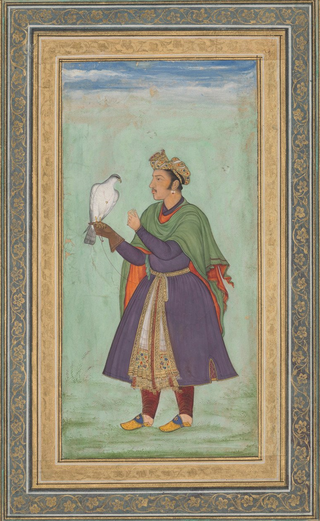
Khusrau Mirza was the eldest son of the Mughal Emperor Jahangir and his first wife, Shah Begum. The young prince displayed exceptional skills and wisdom and had the privilege to be groomed by the Mughal Emperor (Akbar) himself for the throne of the Mughal Empire. He turned out to be the most capable and qualified son of Jahangir but was befallen by an unfortunate destiny. Being Jahangir's eldest son, he was the heir-apparent to his father but Jahangir favoured his son Khurram Mirza as he held an animosity against Khusrau.
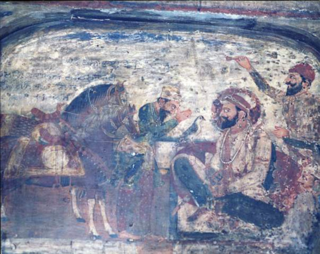
Bidhi ChandChhina was a Sikh religious preacher and military commander, from Chhina Bidhi Chand village, 37 kilometers south of Amritsar and Chhina Bidhi Chand was part of Amritsar District not Lahore. His birth place temple is situated in his own village Chhina Bidhi Chand, which was built by the residents with the help of Baba Daya Singh. Baba Daya Singh laid foundation with his own hands. Every year on his birthday Baba Daya Singh, and now Baba Avtar Singh, would go to village Chhina Bidhi Chand and celebrate it there to date. He was a disciple of Guru Arjan and served Guru Hargobind for most of his life.

Bandi Chhor Divas is a Sikh celebration commemorating the day the sixth Guru of Sikhs, Guru Hargobind and 52 Hindu Kings were released from Gwalior Fort, who had been imprisoned by Mughal Emperor Jahangir. Emperor Jahangir had held 52 Kings at the Gwalior Fort for several months. Gurdwara Data Bandi Chhor Sahib is located at the place of the Guru's internment in the Fort. The day falls in autumn and often overlaps with Hindu Diwali, the festival of lights celebrated across Punjab and the rest of India. Historically, from the time of the third Sikh Guru Amar Das, Sikhs and Hindus of the time used the occasion of Diwali, Vaisakhi and other such festivals to congregate at the seat of the Gurus. In 2003, Sikh religious leaders and the Shiromani Gurdwara Parbandhak Committee led by Prof. Kirpal Singh Badungar formally adopted this day into the Nanakshahi calendar.

The Golden Temple (also known as the Harmandir Sahib, or the Darbār Sahib, is a gurdwara located in the city of Amritsar, Punjab, India. It is the pre-eminent spiritual site of Sikhism. It is one of the holiest sites in Sikhism, alongside the Gurdwara Darbar Sahib Kartarpur in Kartarpur, and Gurdwara Janam Asthan in Nankana Sahib.

Sri Chand, also referred to as Baba Sri Chandra or Bhagwan Sri Chandra, was the founder of the Udasi sect of ascetic Sadhus. Sikh sources give his life the impressive dates of 8 September 1494 – 13 January 1629, which would have made him 134 years old upon his death.
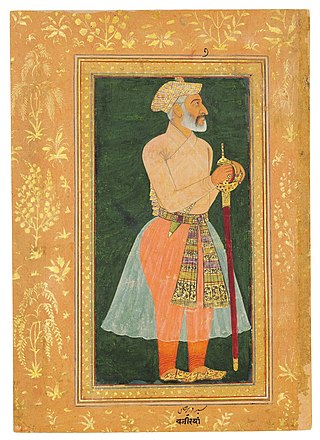
Hakeem Shaikh Ilam-ud-din Ansari, known by his royal title Wazir Khan, was a Mughal administrator and an imperial minister who held the position of grand vizier in the Mughal Empire.
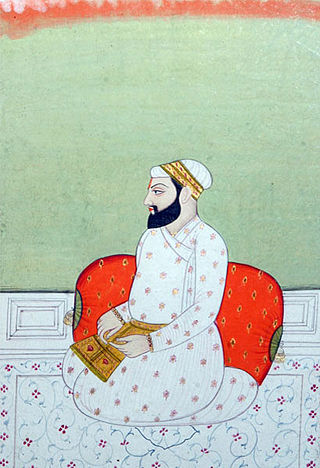
Guru Arjan was the fifth of the ten total Sikh Gurus. He compiled the first official edition of the Sikh scripture called the Adi Granth, which later expanded into the Guru Granth Sahib. He is regarded as the first of the two Gurus martyred in the Sikh faith.
Lohgarh is a historic town in Bilaspur tehsil of Yamunanagar district of Haryana in India. It was the capital of First Sikh State under Baba Banda Singh Bahadur from 1710 to 1716.

The Mīnās were a heretical sect of Sikhs that followed Prithi Chand, the eldest son of Guru Ram Das, after his younger brother Guru Arjan was selected by the Guru to succeed him. Prithi Chand would vigorously contest this, attracting a portion of Sikhs to his side who followers of Guru Arjan referred to as ਮੀਣੇ mīṇe, meaning "charlatans," "dissemblers," or "scoundrels." They sustained their opposition to the orthodox line of Gurus through the seventeenth century, and upon Guru Gobind Singh's founding of the Khalsa in 1699, they were declared by him, as well as by Khalsa rahitnamas, as one of the Panj Mel, or five reprobate groups, that a Sikh must avoid. They are occasionally referred to in the more neutral terms Sikhān dā chhotā mel or as the Miharvān sampraday in scholarship.
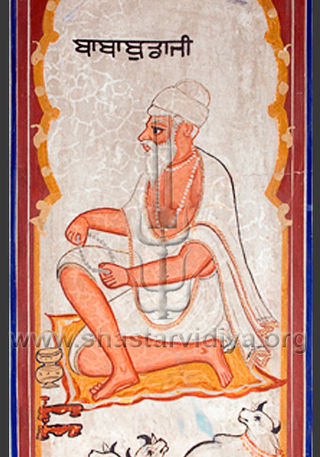
Baba Buddha was a prime figure in early Sikhism.

Prithi Chand, also spelt as Prithia, was the eldest son of Guru Ram Das – the fourth Guru of Sikhism, and the eldest brother of Guru Arjan – the fifth Guru. He founded the heretical Mina sect of Sikhism.

Shaikh Farid Bukhari, also known by the title Murtaza Khan, was a leading Mughal noble during the reign of the Mughal emperors Akbar and Jahangir. He served as governor of Gujarat and later of Punjab. He was also well known as an architectural patron in Mughal India, and founded the city of Faridabad in modern-day Haryana, India.

The Akal Sena was the Sikh military force established by the sixth Sikh Guru, Guru Hargobind. It was the first standing Sikh army. It was also known as the Akali Dal.

















